ISSN ONLINE(2319-8753)PRINT(2347-6710)
ISSN ONLINE(2319-8753)PRINT(2347-6710)
Shankar Gouda1 and Praveen M P2
|
| Related article at Pubmed, Scholar Google |
Visit for more related articles at International Journal of Innovative Research in Science, Engineering and Technology
Collector box is one of the influencing factors for stability of operation of test compressor. Collector box in compressor test facility is used to collect the high pressure exhaust air from the exit of the test compressor. It is subjected to flow fluctuation during compressor testing, making it vulnerable for structural related problems like high vibration. The results indicate that Compressor-Collector box interactions may strongly affect compressor performance unless the lowest resonant frequency of the collector box is much higher than the natural frequency. An analytical and experimental investigation of the static and dynamic behaviour of exhaust Collector box is described, including the effects of compressor-collector box dynamics.
Keywords |
| Exhaust Collector Box, Axial Compressor test facility. |
INTRODUCTION |
| The role of the compressors in a gas turbine is to provide a maximum high pressure air which can be heated in a limited volume of combustion chamber and then expanded through the turbine. The compressor efficiency will determine the power necessary to create the pressure rise of a given air flow and will affect the temperature change which can take place in the chamber. |
| The compressor test facility is used for following; |
| • For performance evaluation (generating performance characteristics). |
| • For establishing safe operating line. |
| • For validation of numerical tools. |
| The role of exhaust collector Box is to collect the high pressure exhaust air from the exit of the test compressor to the atmosphere through throttling valves and its associated ducting system. The collector box is designed to give a fairly uniform pressure distribution at the exit of the test compressor and less overall pressure loss. |
| During the initial test runs on the low pressure compressor, the collector box was found vibrating more. The vibration data collected during test runs showed the frequency component, which is found to be dominating due to resonance. |
| Resonant vibration is mainly caused by an interaction between the inertial and elastic properties of the materials within a structure. Resonance occurs in a structure whenever the excitation frequency matches with the natural frequency of the structure. Resonance is often the cause of, or at least a contributing factor to many of the vibration and noise related problems that occur in structures and operating machinery. |
| To understand any structural vibration problem, the resonant frequencies of a structure need to be identified and quantified. Today, modal analysis has become a widespread means of finding the modes of vibration of a machine or structure. In every development of a new or improved mechanical product, structural dynamics testing on product prototypes is used to assess its real dynamic behaviour. |
GEOMETRICAL CONFIGURATION |
| Geometrical dimensions are shown in fig. 2.1 & fig. 2.2. The model consists of L – stiffeners (186x25x3) mm around the circumference of Collector Box as show in fig. 2.3. |
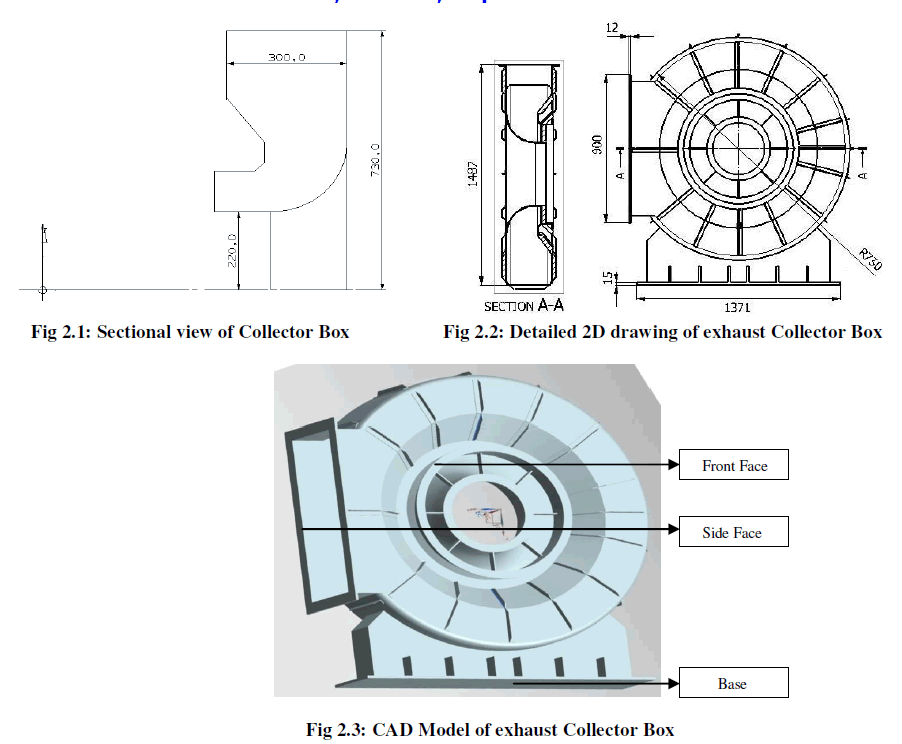 |
MATERIAL SPECIFICATION |
| The Base material of the Collector Box is Mild Steel [1]. |
| 1. Young’s Modulus, E = 2.10E+11N/m2 |
| 2. Poison's Ratio, μ = 0.3 |
| 3. Ultimate Strength, ÃÂñu = 400 Mpa |
| 4. Yield strength, ÃÂñy = 250 Mpa |
LOAD ON THE EXHAUST COLLECTOR BOX |
| Loading condition is defined to be forces distributed on the inner surfaces of the Collector Box as shown in Fig.4.1. Pressure load of 50.611 kPa is imported from CFD analysis & matched the inner surface of collector box. |
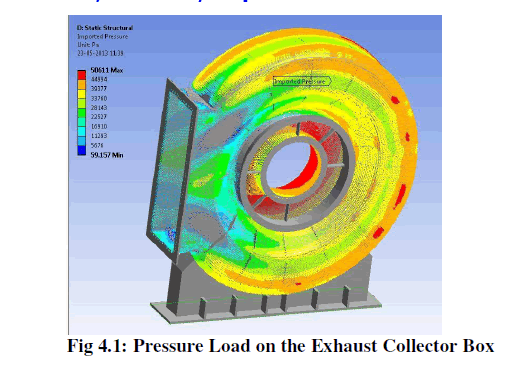 |
MODAL AND STATIC STRUCTRAL ANALYSIS |
| A: Introduction to Modal analysis & Static structural analysis: |
| Modes are inherent properties of a structure, and are determined by the material properties (mass, damping, stiffness) and boundary conditions of the structure. Each mode is defined by a natural (modal or resonant) frequency, modal damping, and a mode shape. If either the material properties or the boundary conditions of a structure change, its modes will change. Modal data are extremely useful information that can assist in the design of almost any structure. |
| Structural analysis is carried out to determine the effects of loads on physical structures and their components. Structures subjected to this type of analysis includes machinery, buildings, bridges, vehicles, furniture etc.. |
| B: The different stages of Modal and static structural analysis: |
| The software used for the analysis of the Exhaust Collector Box is HYPERMESH & ANSYS WORKBENCH. The stages involved are shown in the figure 5.1. |
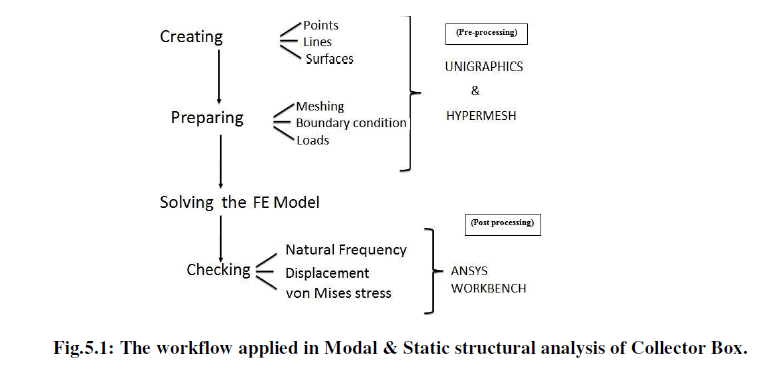 |
FINITE ELEMENT MODEL OF EXHAUST COLLECTOR BOX |
| All dimensions of the complete assembly of the structure are as per the description provided in the previous section in the problem definition chapter. A finite element model is the complete idealization of the entire structural problem including the node location, the element, physical and material properties, loads and boundary conditions. The purpose the finite element model is to make a model that behaves mathematically as being modelled and creates appropriate input files for the different finite element solvers. The FE model using first order tetrahedral elements for the existing Collector Box is created with the help of HYPERMESH 9.0 as shown in Fig.6.1 & Fig. 6.2 shows tetrahedral element (TET4) geometry.The simplest solid element available to the finite element modeller is the first-order four-node tetrahedron or TET4. |
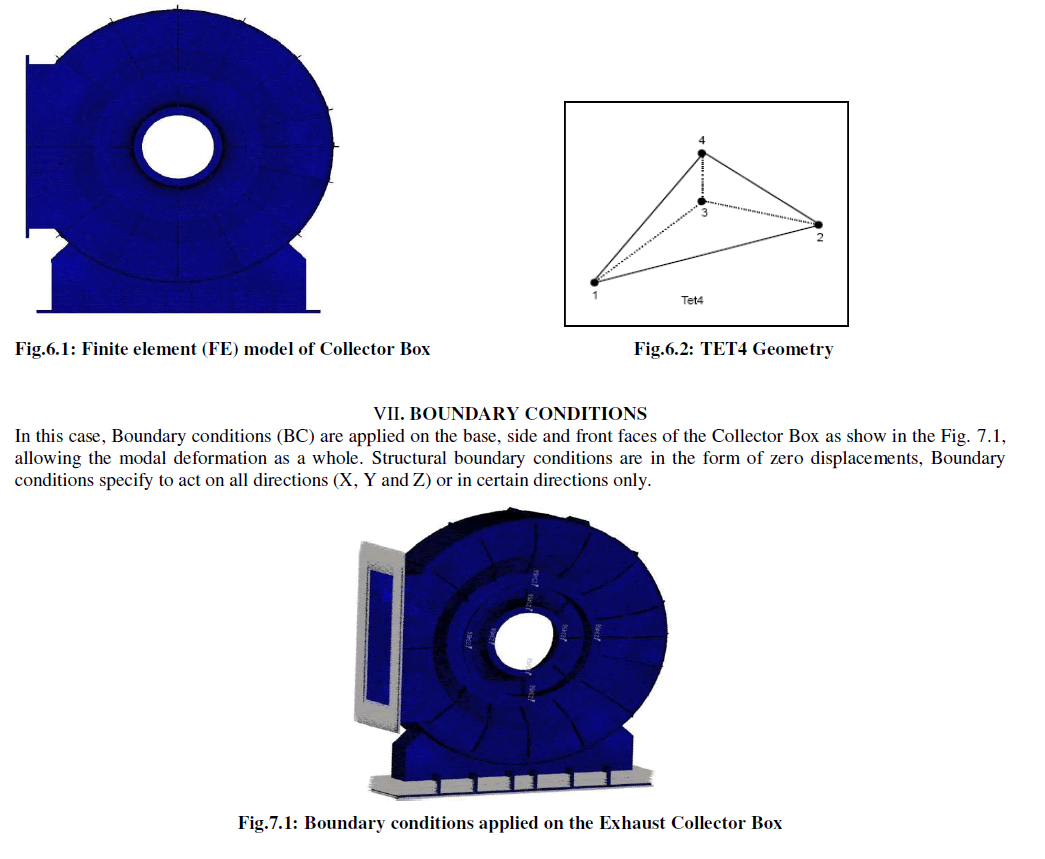 |
RESULTS AND DISCUSSION |
| Terminology & Concepts: |
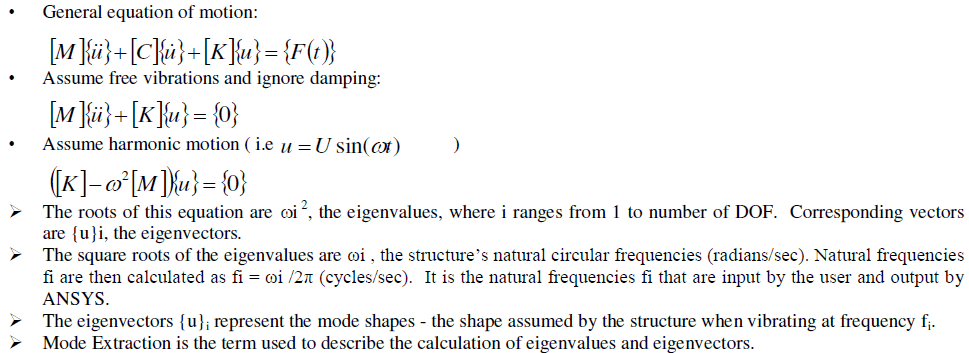 |
| A: Natural Frequencies of exhaust Collector Box without the application of Load: |
| Fig. 8.1 shows Modal analysis of exhaust collector box. FE analysis is compared with the experimental results (Fig. 8.2) conducted at Compressor Test Rig. |
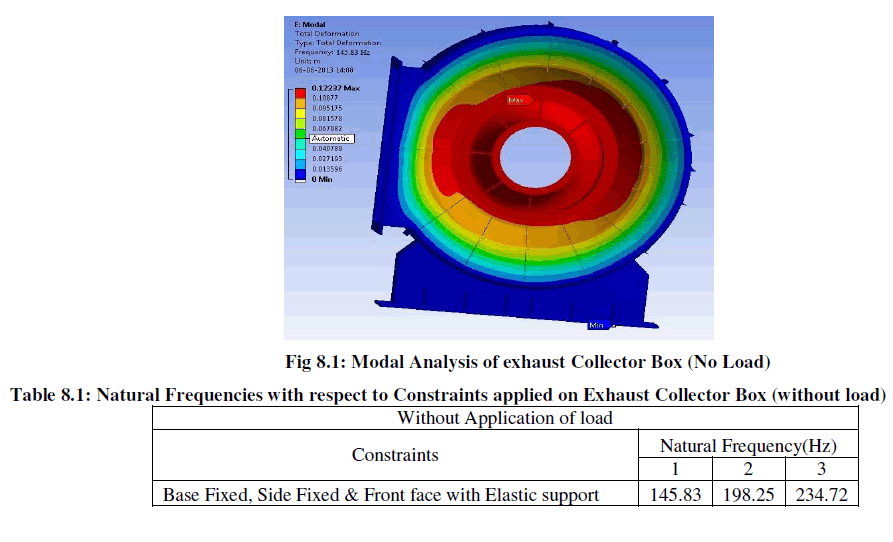 |
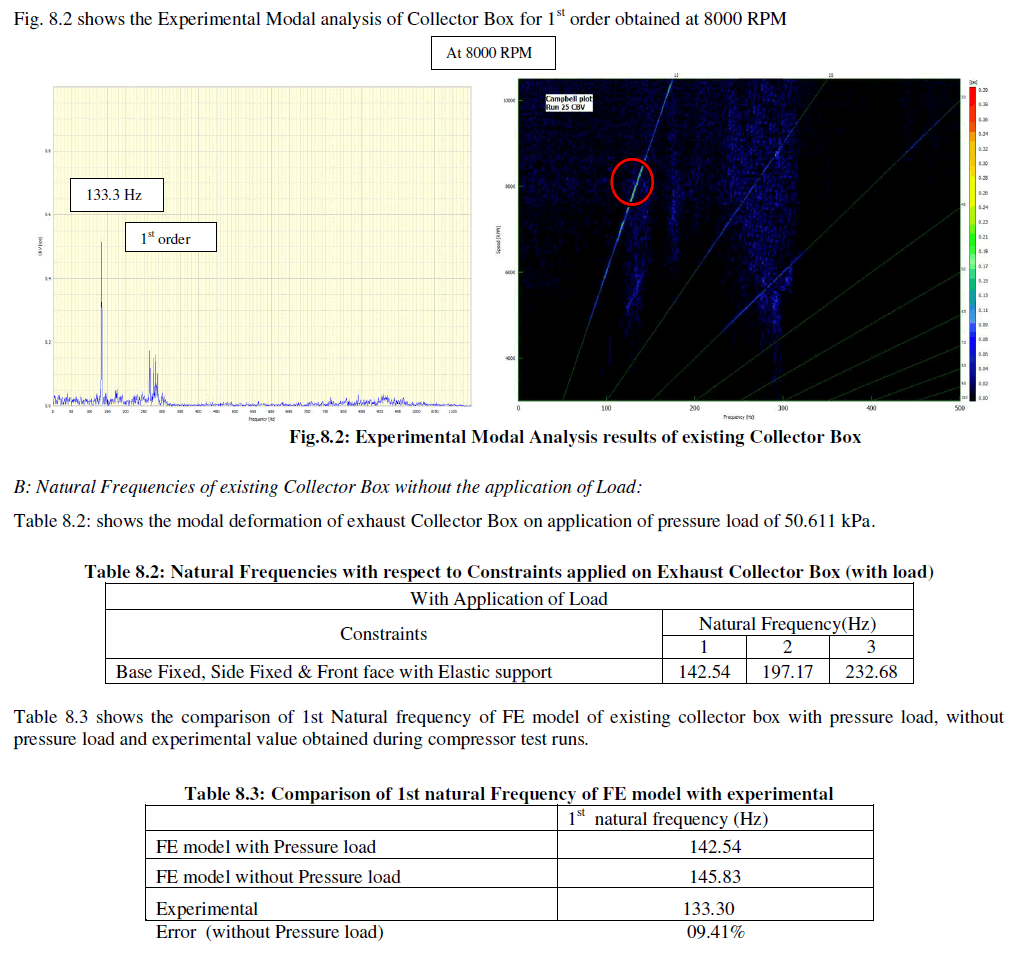 |
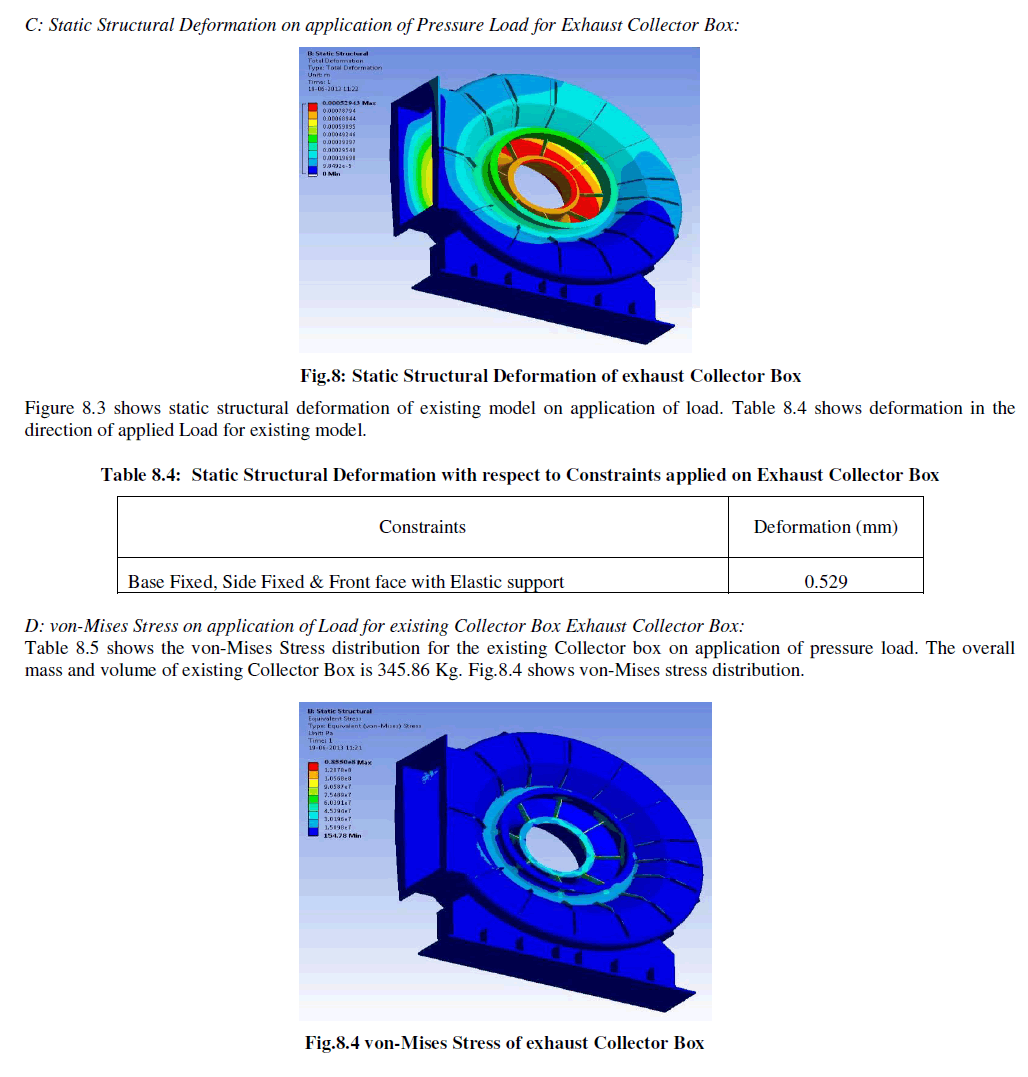 |
 |
| As the material is ductile, maximum Distortion energy theory (von-Mises theory) is considered for determining the criterion for failure. Taking a factor of safety of 2.0[1], the allowable stress for the material is 200 MPa, based on Yield Stress of 400 MPa. Hence, the design of the Collector Box is considered adequate with a Factor of safety of 8.72. |
| We know, Factor of Safety = Ultimate Stress / Working Stress |
CONCLUSIONS |
| The investigation on the dynamic behavior of Exhaust Collector box has been successfully executed in this project. Experimental results were used in conjunction with the finite element to predict the dynamic characteristic of Collector box such as the natural frequency and mode shape. Basically, natural frequency and mode shape are important parameters in design. That is because failure can occur if the Collector Box is excited at its natural frequency during operation. The dynamic characteristic such as the natural frequencies and mode shapes of the Collector box was determined numerically. The experimental data was used to validate a finite element model representing the real structure. The FE model presented an average of 10% higher frequencies than the real Structure. |
References |
|